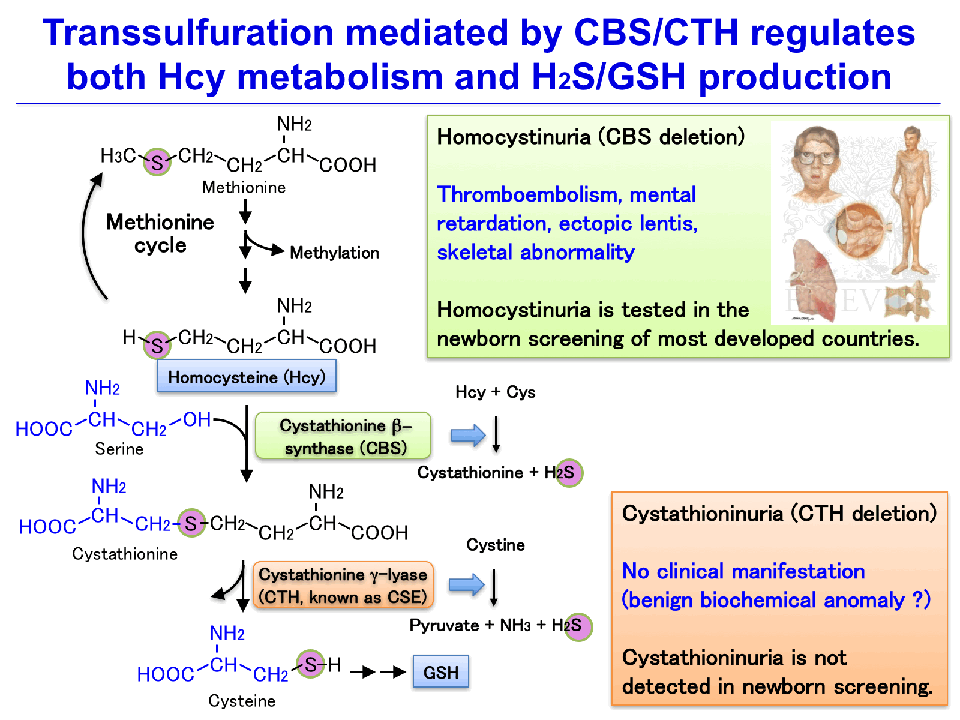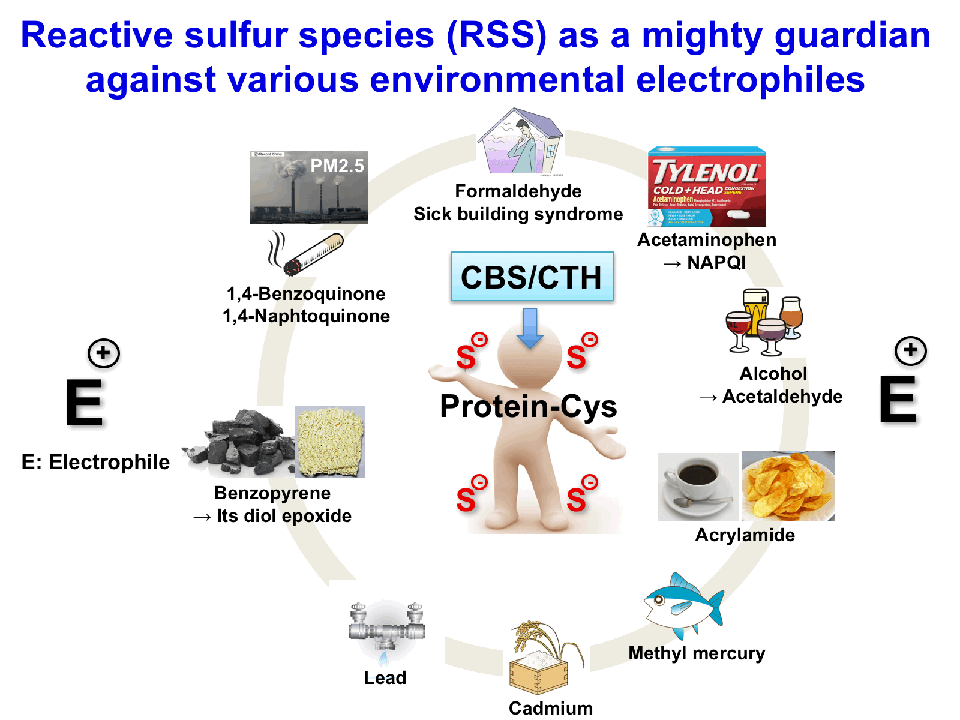Laboratory of Health Chemistry
Staff
Isao Ishii, Ph.D.Professor
Takako Hishiki, Ph.D.Associate Professor
Takamitsu Unoki, Ph.D.Senior Assistant Professor
Akihiro Honda, Ph.D.Assistant Professor
Research subjects
- Physiological roles of sulfur-containing amino acid metabolism and pathological conditions caused by its dysregulation
- Protective roles of hydrogen sulfide (H2S)/reactive sulfur species (RSS) against oxidative stress from various environmental electrophiles
- Metabolic remodeling during fasting/caloric restriction/amino acid deficiency and its implication for clinical application
- Bioactive lysophospholipid (S1P [sphingosine 1-phosphate]/LPA [lysophosphatidic acid]) signaling via its cognate GPCRs
- Metabolism and detoxification of metals/metalloids in organisms
Outlines
Sulfur-containing amino acid metabolism
Cysteine is a sulfur-containing non-essential amino acid that is biosynthesized from methionine (one of nine essential amino acids in human) via methionine cycle and transsulfuration. Cystathionine beta-synthase (CBS) and cystathionine gamma-lyase (CTH) are two essential enzymes for transsulfuration (that converts homocysteine to cysteine via a transfer of its sulfur to serine) as well as endogenous production of hydrogen sulfide, a gaseous transmitter with diverse biological functions including neuromodulation and vasodilation. Meanwhile, an elevated level of blood homocysteine has been considered as an independent risk factor for cardiovascular diseases (CVD) such as stroke and myocardial infarction. Indeed, innate CBS deficiency is known to cause homocystinuira/homocysteinemia whose major clinical manifestation is thromboembolism and nearly half of untreated CBS-deficient patients die from CVD during their thirties. With such reasons, type I homocystinuria (CBS deficiency) is detected in a newborn screening of most developed countries. In contrast, innate CTH deficiency is known to cause cystathionin-uria/-emia that is considered to be a benign biochemical anomaly with no consistent clinical manifestation; therefore, cystathionin-uria/-emia is not tested in the newborn screening and CTH-deficient persons are buried. We are studying physiological/pathophysiological roles of CBS and CTH in the point of view from dysregulation of amino acid metabolism by generating and analyzing mice deficient for CBS and CTH. Importantly, CTH-deficient mice appear normal but display various severe disorders upon various types of stimuli.

Hydrogen sulfide (H2S) and reactive sulfur species (RSS)
CBS and CTH are also known as endogenous H2S/RSS (such as cysteine persulfide)-producing enzymes. Recent experimental evidence suggests that H2S/RSS act through S-sulfhydration/persulfidation of protein cysteine residues. Therefore, CBS/CTH-produced H2S/RSS may counteract the actions of various (often highly toxic) environmental electrophiles. We are investigating the roles of CBS/CTH in H2S/RSS production, protein modification, and protection against environmental electrophiles.

Metabolic remodeling during fasting/caloric restriction/amino acid deficiency
Fasting has been practiced from millennia to prevent obesity, hypertension, asthma, rheumatoid arthritis, seizures, and seizure-associated brain damage. Investigations of clinical studies and experimental animals indicate that intermittent fasting or caloric restriction imparts various clinical benefits to protect against cardiovascular diseases, diabetes, cancers, and neurodegeneration. However, the underlying molecular mechanisms are not fully elucidated. A recent study demonstrated that endogenous H2S production is essential for dietary restriction benefits and we reported the absence of fasting-induced cardioprotection in either CBS- and CTH-deficient mice. Therefore, H2S/RSS could be involved in metabolic remodeling to confer clinical benefits by fasting or caloric restriction. Furthermore, the deprivation of any single amino acid (not only essential amino acids but also for non-essential ones) from diet could cause systemic metabolic remodeling. We are investigating metabolic remodeling by all such interventions to aim at their clinical application.
Bioactive S1P/LPA signaling via its cognate GPCRs
S1P and LPA are lysophospholipid mediators that derive from plasma membrane lipid components, act on their cognate GPCRs, 5 S1P (S1P1–S1P5) and 6 LPA (LPA1–LPA6) receptors, and exerts a variety of biological effects. Using mice deficient for each receptor, we are investigating receptor-mediated S1P/LPA signaling in vivo.
Metabolism and detoxification of metals/metalloids in organisms
Selenium (Se) and tellurium (Te) are members of the Group 16 elements to which oxygen and sulfur (S) belongs. They are present in biota in the forms of various chemical species such as inorganic salts and Se-/Te-containing amino acids. To fully understand the overall toxicity of such metals/metalloids to humans and animals, we are exploring novel seleno-/telluro-metabolites in biota and investigating their metabolisms in animals by mass spectrometry analyses using LC-ICP-MS, LC-ESI-Q-TOF-MS and LC-ESI-Q-TOF-MS/MS.
Laboratory
-
- Laboratory of Pharmacology
- Laboratory of Pharmacotherapeutics
- Laboratory of Clinical Pharmacy
- Laboratory of Pharmaceutics
- Laboratory of Drug Metabolism and Pharmacokinetics
- Laboratory of Organic Chemistry
- Laboratory of Drug Design and Medicinal Chemistry
- Laboratory of Pharmaceutical Organic Chemistry
- Laboratory of Pharmacognosy and Natural Products Chemistry
- Laboratory of Pharmacy Practice
- Laboratory of Applied Therapeutics
- Laboratory of Drug Informatics
- Laboratory of Community Medicine
- Laboratory of Clinical Community Psychology
- British Caltural Studies
- English Education
- Laboratory of Applied Mathematics, SHIGETA
- Laboratory of Mathematical Sciences, TAKIZAWA